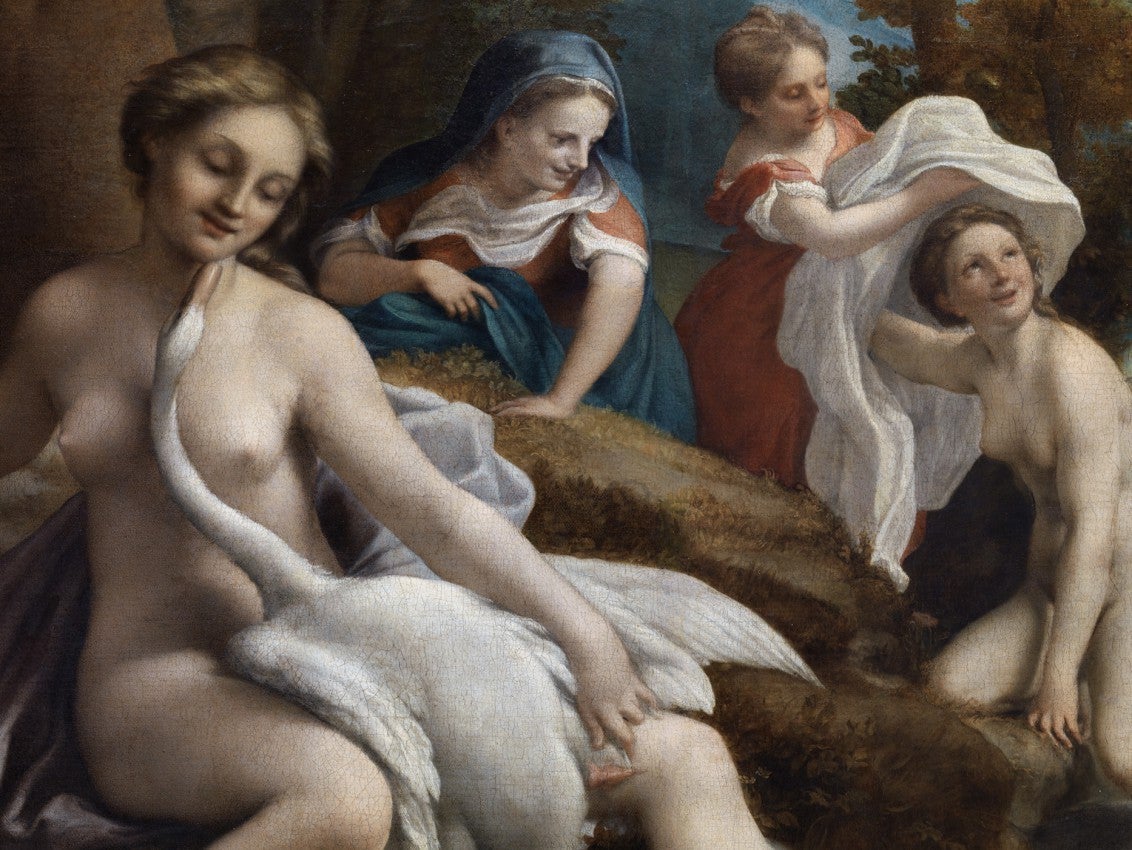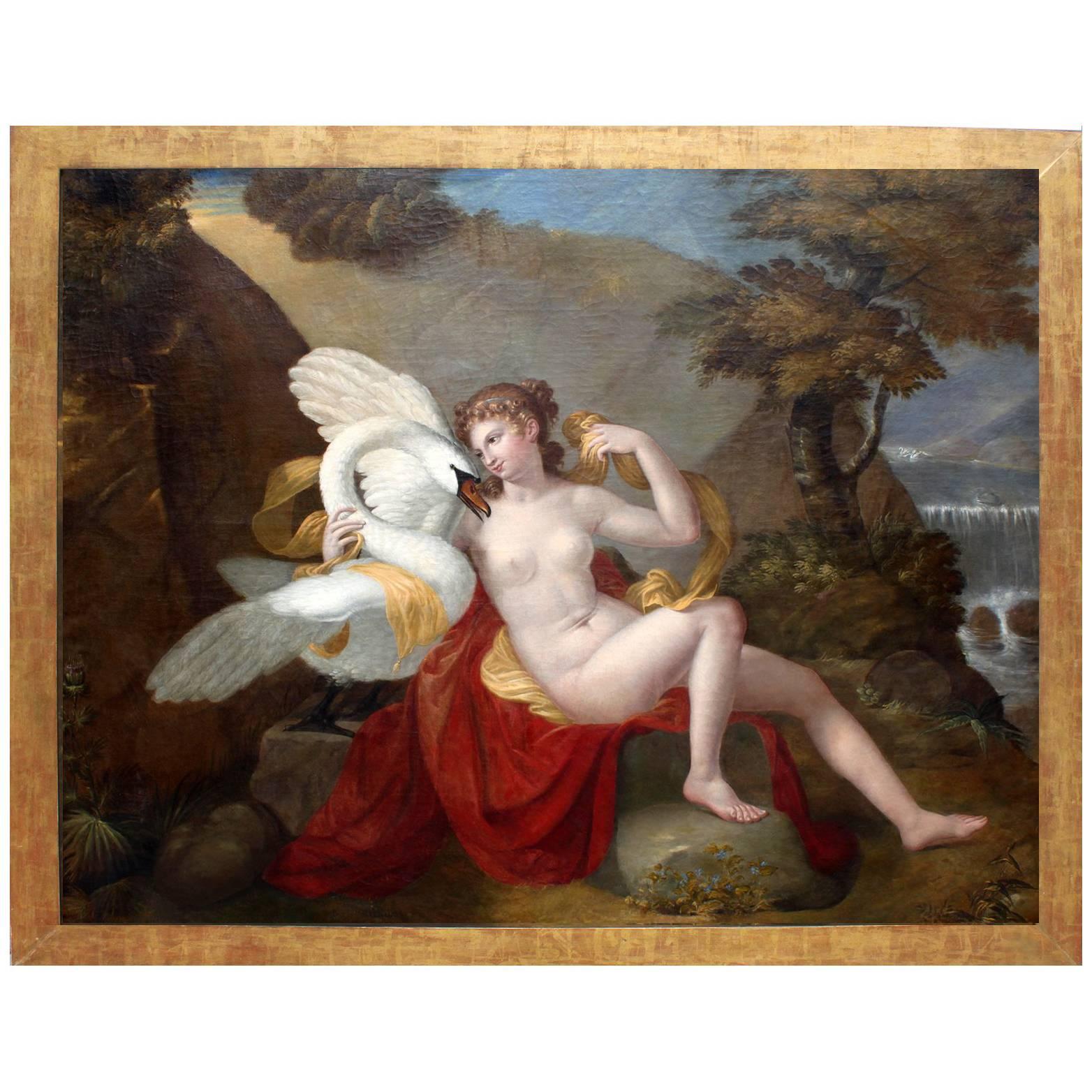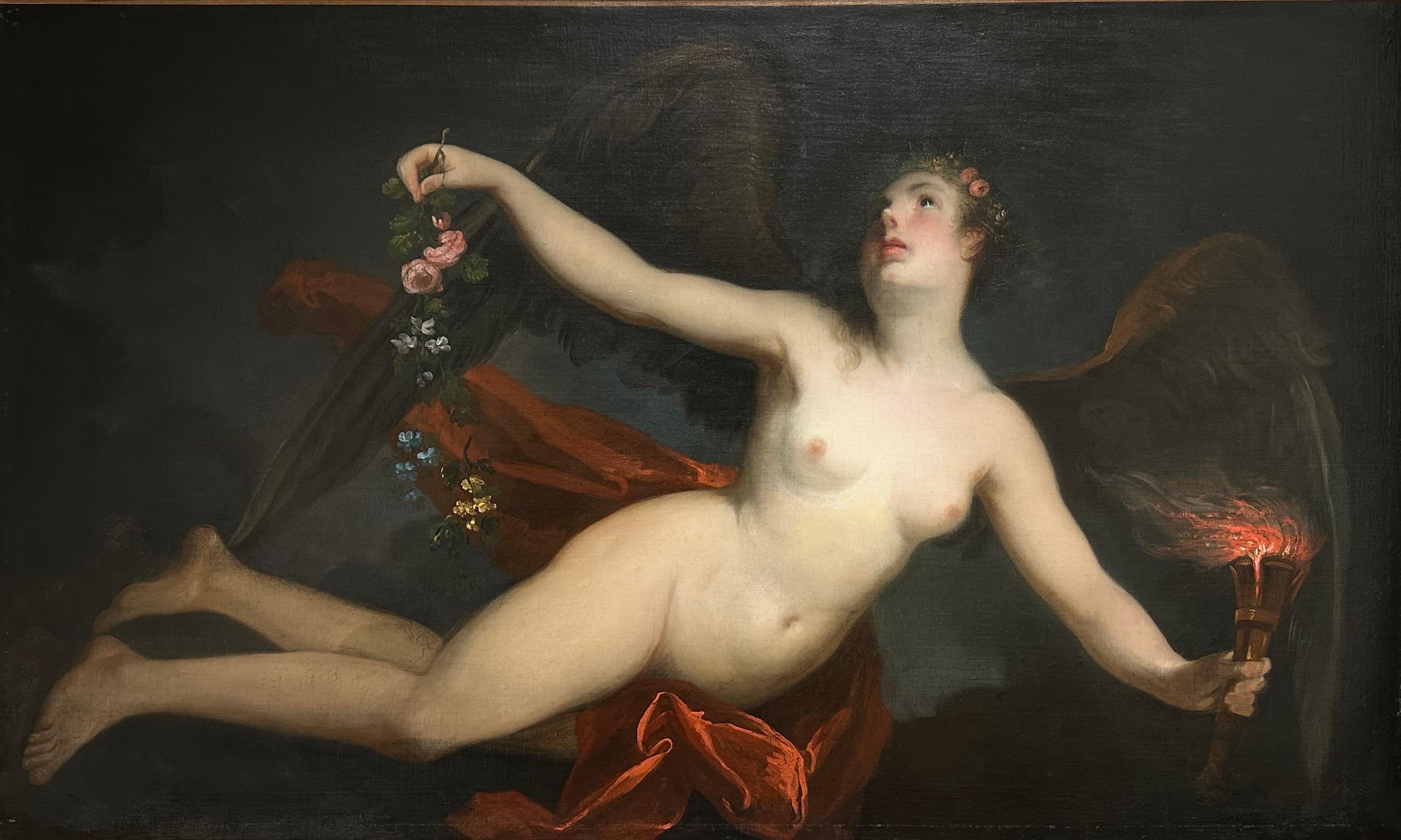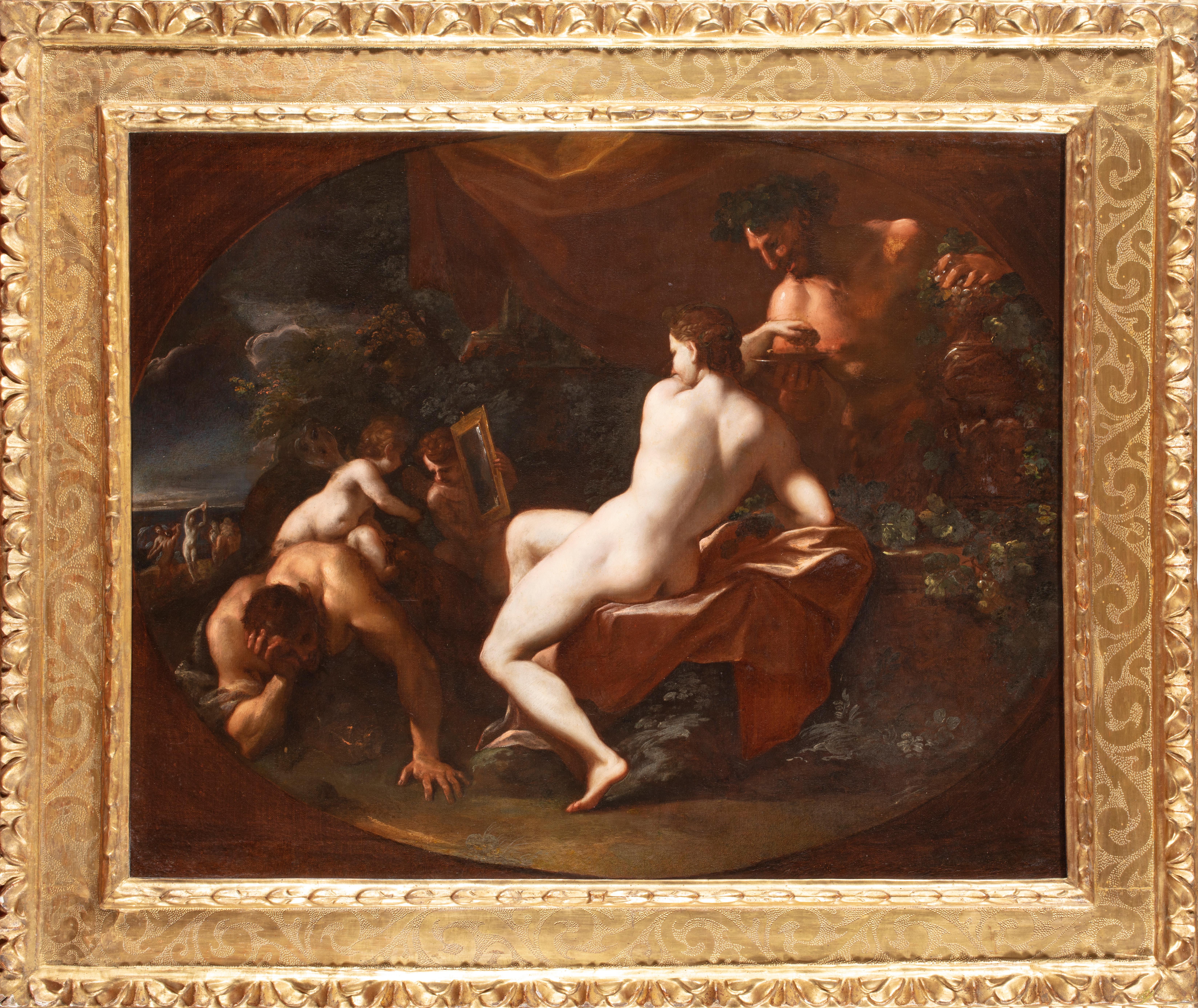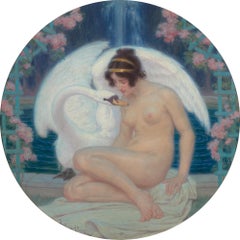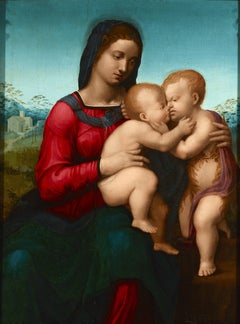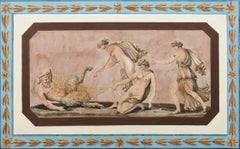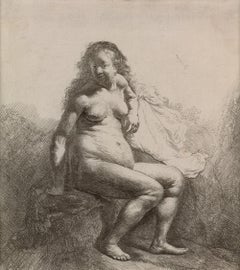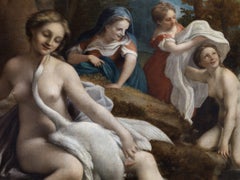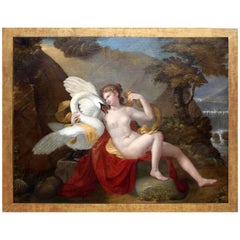Items Similar to Leda And The Swan By Workshop Of Bartholomaeus Spranger
Want more images or videos?
Request additional images or videos from the seller
1 of 10
Bartholomaeus SprangerLeda And The Swan By Workshop Of Bartholomaeus SprangerLate 16th century
Late 16th century
Price Upon Request
Price Upon Request
Price Upon Request
Price Upon Request
Price Upon Request
Price Upon Request
Price Upon Request
Price Upon Request
Price Upon Request
Price Upon Request
About the Item
Workshop of Bartholomaeus Spranger
16th Century Flemish
Leda and the Swan
Oil on panel
Retelling one of the most legendary Greco-Roman mythological tales, this exceptional oil on panel of Leda and the Swan is credited to the workshop of the great Flemish master Bartholomaeus Spranger. The story, in which Zeus transforms into a swan to seduce the young beauty Leda, has been taken up by artists since antiquity, and this painting represents a particularly sophisticated rendition of the myth. Leda is depicted as a languishing and voluptuous female nude, as Zeus, in the form of a swan, hovers over her figure in the background. Their children, Helen and Pollux, surround their mother, while a cherubic Cupid occupies the lower right corner of the scene. Lively and vibrant, the scene bears the very best characteristics of Spranger's workshop, exemplifying the elements that make his works so treasured.
Spranger was renowned for his painterly style that was revolutionary for its merger of northern European and Italian painterly techniques. Leda and the Swan reveals these same stylistic tendencies. The richness of color and the seductive expression of Leda, complete with her limpid yet direct gaze, recall the master artists of 16th-century Italy, such as Parmigianino and late Michelangelo. It particularly recalls Michelangelo's lost 1530s version of the same subject (a copy of which is in London's National Gallery), especially in the placement of the swan and Leda's draped posture.
The painting's attention to detail, however, reveals a link to Netherlandish traditions. A number of elements can be directly linked to other works by Spranger; the lavish, bejeweled gold arm cuff that Leda wears on her upper left arm, for instance, is strikingly similar to the cuff that appears on the nude nymph Scylla in Spranger's Glaucus and Scylla (Kunsthistorisches Museum, Vienna).
There are also parallels in the atmospheric effects conveyed in the background of each composition. In Glaucus and Scylla, storm clouds loom over the horizon, rendered with soft washes of colliding color. A similar effect is created in Leda, wherein the hint of the landscape beyond – appearing just over the swan to the right – is captured with delicate washes of color. Taken as a whole, the oil echoes all of the qualities characteristic of Spranger's later 16th-century work, a period during which he developed a larger circle of associates; it is among his workshop that this painting can thus be determined as originating.
As one of the most noted European painters working in the 16th century outside of Rome, Flemish master Bartholomaeus Spranger enjoyed incredible acclaim for his lively and vibrant painterly style. Though he was known to invoke subjects ranging from the religious to the mythological, it is for his mythological scenes that Spranger is most well-known today. This painting of Leda and the Swan, which bears the characteristics of Spranger's workshop, exemplifies the elements that make his works so treasured.
Late 16th century
Panel: 33 5/8" high x 46 7/8" wide
Frame: 41 5/8" high x 54 1/2" wide
- Creator:Bartholomaeus Spranger (Flemish)
- Creation Year:Late 16th century
- Dimensions:Height: 41.63 in (105.75 cm)Width: 54.5 in (138.43 cm)Depth: 1.63 in (4.15 cm)
- Medium:
- Movement & Style:
- Period:
- Condition:
- Gallery Location:New Orleans, LA
- Reference Number:Seller: 31-02011stDibs: LU18613807482
About the Seller
5.0
Vetted Professional Seller
Every seller passes strict standards for authenticity and reliability
Established in 1912
1stDibs seller since 2013
19 sales on 1stDibs
Typical response time: 10 hours
- ShippingRetrieving quote...Shipping from: New Orleans, LA
- Return Policy
Authenticity Guarantee
In the unlikely event there’s an issue with an item’s authenticity, contact us within 1 year for a full refund. DetailsMoney-Back Guarantee
If your item is not as described, is damaged in transit, or does not arrive, contact us within 7 days for a full refund. Details24-Hour Cancellation
You have a 24-hour grace period in which to reconsider your purchase, with no questions asked.Vetted Professional Sellers
Our world-class sellers must adhere to strict standards for service and quality, maintaining the integrity of our listings.Price-Match Guarantee
If you find that a seller listed the same item for a lower price elsewhere, we’ll match it.Trusted Global Delivery
Our best-in-class carrier network provides specialized shipping options worldwide, including custom delivery.More From This Seller
View AllLeda and the Swan by Ludovic Alleaume
By Ludovic Alleaume
Located in New Orleans, LA
Ludovic Alleaume
1859-1941 French
Leda and the Swan
Oil on canvas
Signed (lower left)
This spectacular circular composition by Ludovic Alleaume presents one of mythology's most e...
Category
20th Century Figurative Paintings
Materials
Oil, Canvas
Virgin and Child with the Infant Saint John
By Domenico Puligo
Located in New Orleans, LA
A masterful example of Italian Mannerist painting, this exceptional panel was composed by the renowned Florentine painter Domenico Puligo. Alongside Jacopo Pontormo and Rosso Fiorentino, Puligo is remembered as one of the foremost figures of the Mannerist movement that rose to prominence during the 16th century in Florence. This panel of the Virgin Mary with the Christ child and Saint John the Baptist is a characteristic example of his celebrated devotional images, which grace museums such as the Metropolitan Museum of Art (New York), Museo del Prado (Madrid), Palazzo Borghese (Rome), and Palazzo Pitti (Florence), among many others.
Puligo’s skill with color is fully demonstrated in the beautifully preserved work. Considering its age, the vibrancy and the sheer range of color is remarkable. The Virgin Mary’s crimson dress...
Category
16th Century Mannerist Portrait Paintings
Materials
Oil, Panel
Italian Panel with Satyr and Nymphs
Located in New Orleans, LA
This extraordinary Italian gouache and oil on canvas brings two of the most popular characters from Greek mythology vividly the life - the nymph and the satyr. Both creatures are famed for their carefree natures and lascivious temperaments, and tales abound of satyrs pursing nubile nymphs in order to rape or seduce them, usually with little success. One such narrative humorously unfolds in the present piece, which depicts an indignant satyr captured by three nymphs with a golden net.
The relationship between these two mythological creatures was a popular one for artists throughout the 18th and 19th centuries, though its origins stretch back to antiquity. Both satyrs and nymphs...
Category
Early 19th Century Other Art Style Figurative Paintings
Materials
Canvas, Oil, Gouache
Price Upon Request
Naked Woman on a Mound by Rembrandt van Rijn
By Rembrandt van Rijn
Located in New Orleans, LA
Rembrandt van Rijn
1606-1669 Dutch
Naked Woman on a Mound
Etching on paper
Etched by Rembrandt
New Hollstein 88, second state of II; Bartsch, Hollstein 198; Hind 43
One of the gr...
Category
17th Century Old Masters Figurative Prints
Materials
Etching
Mutine
By Guillaume Seignac
Located in New Orleans, LA
Guillaume Seignac
1870-1924 French
Mutine
Signed “G. Seignac” (lower right)
Oil on canvas
A mischievous maiden dominates this garden scene by French Academic artist Guillaume S...
Category
Late 19th Century Academic Nude Paintings
Materials
Canvas, Oil
Young Mother Contemplating Two Embracing Children by William-Adolphe Bouguereau
By William-Adolphe Bouguereau
Located in New Orleans, LA
William-Adolphe Bouguereau
1825-1905 French
Jeune mère contemplant deux enfants qui s'embrassent
(Young Mother Contemplating Two Embracing Children)
Signed “W-Bouguereau” (bottom ...
Category
19th Century Academic Figurative Paintings
Materials
Canvas, Oil
You May Also Like
Reinhard Görner – Leda with Swan, 1532, Correggio – Painting Detail Photograph
By Reinhard Görner
Located in Los Angeles, CA
Reinhard Görner’s Leda with Swan unveils an intimate and evocative perspective on Correggio’s 16th-century masterpiece, capturing the painter’s exquisite handling of light, texture, ...
Category
Early 2000s Conceptual Figurative Photography
Materials
Lambda
Reinhard Görner – Leda with Swan, 1532, Correggio – Painting Detail Photograph
By Reinhard Görner
Located in Los Angeles, CA
Reinhard Görner’s Leda with Swan unveils an intimate and evocative perspective on Correggio’s 16th-century masterpiece, capturing the painter’s exquisite handling of light, texture, ...
Category
Early 2000s Conceptual Figurative Photography
Materials
Lambda
Leda Swan Mythological Paint oil on canvas French Painter 18th Century
Located in Riva del Garda, IT
French painter of the late 18th-early 19th century
Leda and the Swan (Literary source: Metamorphoses by Ovid, Book VI)
Oil on canvas 95 x 126 cm Framed 109 x 142 cm
This c...
Category
18th Century Old Masters Paintings
Materials
Oil
$11,698 Sale Price
20% Off
French 19th Century Old Master School Oil on Canvas Titled "Leda and The Swan"
Located in Los Angeles, CA
A fine and large French 19th century old master school oil on canvas titled "Leda and The Swan" within a giltwood frame. Leda and the swan is a motif from Greek mythology, in which Z...
Category
Antique 19th Century French Renaissance Revival Paintings
Materials
Giltwood, Canvas
$49,850 Sale Price
40% Off
Huge 18th Century French Rococo Old Master Oil Allegorical Nude Winged Lady
Located in Cirencester, Gloucestershire
The Allegorical Winged Nude Lady, adorned with the attributes of Spring
French School, 18th century (Rococo period)
oil painting on canvas, unframed
canvas: 30 x 52 inches
provenance...
Category
18th Century Rococo Figurative Paintings
Materials
Oil, Canvas
17th Century By Domenico Maria Canuti Toilet of Venus with Cupids and Satyrs
Located in Milano, Lombardia
Domenico Maria Canuti (Bologna 1626 - 1684)
Title: Toilet of Venus with Cupids and Satyrs
Medium: Oil on canvas
Dimensions: without frame 79 x 98 cm - ...
Category
Late 17th Century Old Masters Figurative Paintings
Materials
Cotton Canvas, Canvas, Oil
More Ways To Browse
16th Century Italian
16th Century Old Master Painting
Large 16th Century Oil Paintings
Leda And Swan
Nymphs Nude
16th Century Italian Religious Painting
Oil Paintings Of Swans
Gold Arm Cuff
Nude Male Original
Russia Nude
Zsa Zsa
Nude Couple Painting
Zsa Zsa Gabor
Nude Bather Painting
Woman Black Oil Nude
Vintage Nude Oil Painting
Cubist Nude Oil Painting
Naked Oil Painting
